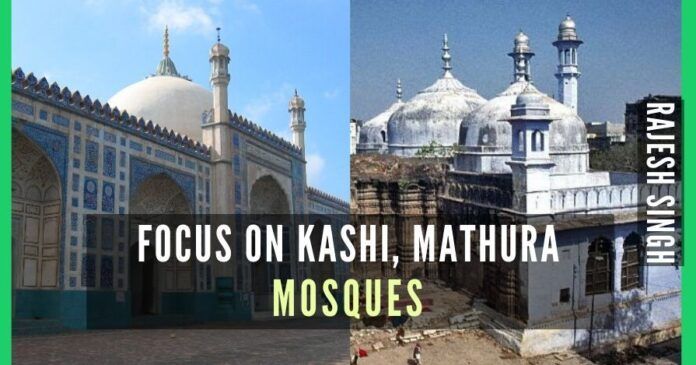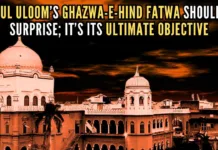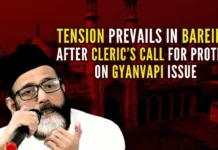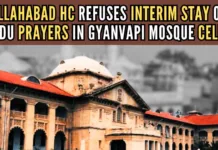
There is no legal route to lawfully challenge the continuing presence of the two mosques on encroached temple property
With the Ayodhya dispute settled in their favour by the Supreme Court, some Hindu organizations are now eyeing the mosques adjacent to the Kashi Vishwanath Temple (in Varanasi) and the Krishna Janmabhoomi Temple (in Mathura). The Gyanvapi Mosque and the Shahi Idgah Mosque respectively came up after the demolition of temples, which were later reconstructed.
The first step has been taken by a Lucknow-based trust, Vishwa Bhadra Pujari Purohit Mahasangh. It has petitioned the Supreme Court, challenging the validity of Section 4 of The Places of Worship (Special Provisions) Act, 1991. It is because, as long as this Act remains in place in the form it exists today, there is no legal route to lawfully challenge the continuing presence of the two mosques on encroached temple property.
The plea said that Parliament, by way of the Act, retrospectively created a cut-off date of August 15, 1947, for its implementation.
The legislation had been enacted by the Narasimha Rao government in 1991, almost a year before the Babri Mosque, was demolished in Ayodhya. The main purpose of the Act was to “prohibit conversion of any place of worship and to provide for the maintenance of the religious character of any place of worship as it existed on the 15th day of August 1947, and for matters connected therewith or incidental thereto.” The Ayodhya issue was kept out of this law’s purview since it was already under adjudication. The idea was to maintain the nature of a place of worship, whether a temple, mosque, church, or any other religious shrine. But the move was seen as primarily to preempt attempts to legally target the continuation of the mosques adjacent to the Shiva temple in Varanasi and the Krishna temple in Mathura since many Hindu bodies then had announced that they would not rest unless these shrines were ‘liberated’.
The Mahasangh has challenged the constitutional validity of Section 4, arguing that it “barred the right and remedy against encroachment made on the religious property of Hindus” by invaders and others before August 15, 1947. it added that Parliament had through the Act retrospectively determined cut-off date.
The plea said that Parliament, by way of the Act, retrospectively created a cut-off date of August 15, 1947, for its implementation. The Act declares that the character of a place of worship as in existence on that day, shall be maintained and that no suit or any proceeding shall lie in any court in respect of any dispute against the encroachment of any religious properties at any point of time before this date.
The petition further said, “The result is that Hindu devotees cannot raise their grievance by instituting any suit in Civil Court or invoking the jurisdiction of the Honourable High Court under Article 226 of the Constitution of India against high handiness (sic) of ultras and will not be able to restore back the religious character of Hindu endowments, temples, mutts, etc from hoodlums if they had encroached upon such property before 15th August 1947…”
For the Hindus, the celestial world may be ruled by the triumvirate of Brahma-Vishnu-Mahesh. But on earth, it is the Shiva-Rama-Krishna trio that is most revered.
Incidentally, the Supreme Court had observed in its verdict on the Ayodhya dispute that The Places of Worship Act reflected the secular values of the Constitution. “The law is hence a legislative instrument designed to protect the secular features of the Indian polity, which is one of the basic features of the Constitution.”
The Mahasangh’s petition has been challenged with great promptness by a prominent Muslim body, the Jamiat Ulama-i-Hind (JUH). Arguing that it be given a chance to contest the petition, the JUH said the court should not even issue a notice since it would make the Muslim community in the country insecure, more so after the Ayodhya verdict.
Meanwhile, there will be many who will argue that the Mathura and Varanasi mosques’ issues should not be raised. After all, several temples were destroyed by Muslim invaders and during Mughal rulers, and all of that cannot be reversed since it would lead to chaos and communal disharmony on a large scale in the country. However, they should not miss the point that the Kashi Vishwanath Temple and the Krishna Janmabhoomi Temple have a special place for millions of Hindus in the country and elsewhere. Varanasi is the land of Lord Shiva and the temple in his name in the city is the foremost of all temples that exist of this deity anywhere in the world. The Mathura temple complex stands where Lord Krishna was said to be born. Both these temples were destroyed and rebuilt later. The mosques that stand in the vicinity are incongruous to the religious sentiments of Hindus.
For the Hindus, the celestial world may be ruled by the triumvirate of Brahma-Vishnu-Mahesh. But on earth, it is the Shiva-Rama-Krishna trio that is most revered. Therefore, there is added religious importance to their most prominent shrines. There are many numbers of temples in the country dedicated to the three, but the ones in Varanasi, Mathura, and Ayodhya are the spearheads.
Nobody is arguing that these mosques should be demolished like the Babri structure. That should never happen. But any closure of legal remedies to address the matter could be dangerous since it can arouse passions and has the potential to result in a major confrontation between the communities. After all, it was the Supreme Court that brought an end to the decades-old dispute in Ayodhya, and if it is called upon to settle the Kashi and Mathura issues, it would be good if it addresses the matter, even if it means revisiting the Places of Worship Act.
Note:
1. The views expressed here are those of the author and do not necessarily represent or reflect the views of PGurus.











[…] of the religious character of any place of worship as it existed on the 15th day of August 1947, and for matters connected therewith or incidental […]
[…] of the religious character of any place of worship as it existed on the 15th day of August 1947, and for matters connected therewith or incidental […]
[…] of the religious character of any place of worship as it existed on the 15th day of August 1947, and for matters connected therewith or incidental […]
It took close to a 100 yrs to reclaim Ayodhya temple through legal means. Does that look like rampage and loot to you? In fact it is precisely because we are a peace loving people who have welcomed all with open arms through the centuries that we now have to beg for our places of worship to be restored.
This was the problem and reason why the Babri masjid ram temple title dispute had no clear verdict for a very long period because the Hindu group will start capturing places of other religion in the name.of Reclaiming Temples by spreading hatred and propoganda. After Demolishing Babri masjid now they are eyeing on each and every Islamic and Christian monument. They are even eyeing on Jama Masjid Delhi, Hazrat Nizamuddin Dargah Delhi, Taj Mahal Agra which have zero indication of any razed temple. This called Ungali di thi poors hath hi pakad liya.. This greed has no end. This stupid game must be stopped immediately.
Are you really blaming the victims? Who is the real greedy ones, the natives or the invaders?
Don’t confuse demolition with rebuilding.
Invaders demolished.
Colonial powers demolished.
Natives rebuild. Never confuse yourself about the real aggressors.
“This was the problem and reason why the Babri masjid ram temple title dispute had no clear verdict for a very long period ”
You are wrong. The real reason was because the invaders were not really gone.
Even when they physically left, the systems still worked as if they were here.
If a segment of society wants to keep the memories of invaders alive let them assume the cost of rebuilding also. They can’t only leech on the benefits and pay none of the rebuilding costs.
Muslims did that looted destroyed and constructed mosques there … Hindus are claiming what is theirs…u guys said same thing for Ram mandir tooo but it was proved that there was a temple similarly others will be proved someday but we are not planning any such thing for now since we atleast have temples there unlike ayodhya
Can the author confirm whether namaz was being offered at Kashi and Mathura temple / mosque structures on 15th Aug 1947 ? In case there was no namaz, then who owns the land and if in confusion can’t govnt acquire these places and hand it to Hindus ?
Author is being apologetic , not to demolish existing structure. Presuming these places are handed over to Hindus today , how are they going to construct temple without demolishing the current structure.
Mosque is only a prayer hall which can be shifted to any place. A temples location has significance and cannot be shifted. Any how mess is created during partition and the Muslim pak wiped out all temples. We are harping on a man made law which goes against dharmic principles, hence decay in our society.
1947 isn’t the date of comparison. The date is the day before the building was destroyed. 1947 honors the existing building rather than the demolished temple.
Invaders and colonial powers don’t get to decide the date.
Was referring to act passed in 1991, pertaining to status quo as on 1947.Was it necessary ? What prevented the govnt to acquire the temple land When Namaz was not being done since 1920. True, invaders don’t decide the date, then some one has to decide a date, but what is the benefit of being independent ? Scared of Muslims, even afteryou surrendered land to them.
Had the Hindus invaded and demolished Mosques or churches, would these people and champions of appeasement politics have kept mum!!!? Justice demands that all the religious places so invaded and demolished be restored honourably forthwith and culprits strictest punished for their hateful barbarism!
Like what happened in ayodhya verdict if Muslims of the country want to feel secure and part of the country they should seek land elsewhere to build a mosque and hand over these mosques to the temple trust
What they are trying to show with words like insecure, secular etc is that we still can control the narrative even 70 years after partition
This will backfire on their thinking and majority community is fed up with this kind appeasement which many political parties have been stoking for decades
“The mosques that stand in the vicinity are incongruous to the religious sentiments of Hindus.”
Or better yet, the current structures celebrate the barbarism of invaders at the expense of native deities.
There is simply no reason to glorify invaders this way. If they need to be celebrated, create a permanent one room exhibit in a museum and call it done.
Um, legal or not, there is no standing period. There is no reason to honor remnants of a defeated alien force. They invaded, destroyed some buildings and got defeated sometime later. So then next step if for the native inhabitants to rebuild the destroyed building. Why is this up for debate?